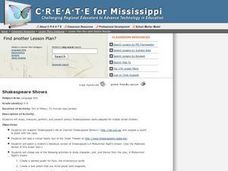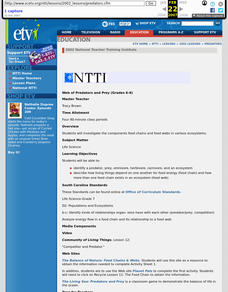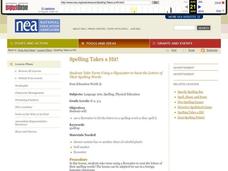Alabama Learning Exchange
Why Does It Rain?
Students investigate the water cycle. They observe a demonstration of the water cycle involving ice, water, bowls, and steam, explore various websites, and listen to the book, "The Magic School Bus: Wet All Over: A Book About the Water...
Curated OER
Water Treatment Plant
Second graders create their own water treatment system. In this water treatment instructional activity, 2nd graders create the water treatment system and record how it works. Students list materials they used and write about what they...
Curated OER
Literary Wizardry
Students discuss what they already know about the Harry Potter series. After reading an article, they examine a critic's reaction to the latest book in the series. As a class, they brainstorm what parts of their school day could use...
Curated OER
Life of a Navajo Weaver
Students explore Native American weaving patterns and dance movements. In this Native Americans lesson, students view examples of weaving patterns on the Internet and compare the patterns to a Native American dance. Students demonstrate...
Curated OER
Water Cycle
First graders research for information on the water cycle. They use a hot list to find pictures of the water cycle, and create a movie in Kid Pix about the water cycle.
They present Kid Pix movie to the class.
Curated OER
A Bug's Journey
Students research the art of John Baldessari. In this art history lesson, students examine Baldessari's drawing of a beetle and discuss the characteristics of these bugs. They write a story from a bug's perspective and create their own...
Curated OER
Food Chain/Food Web
Students explore ecosystems. In this ecology lesson, students read an article explaining ecosystems. Students create a visual organizer with index cards using components of various ecosystems.
Curated OER
The Checks Lab
Learners, in teams, have an envelope containing a series of bank checks. A few are removed at a time, and the team attempts to construct a plausible scenario which involves those checks.
Curated OER
Shakespeare Shows
Young scholars study, interpret, perform, and present various Shakespearean works adapted for middle school Students. They choose a scene from one of the plays covered in this teaching unit to reenact with a group.
Curated OER
Mystery Boxes: Uncertainty and Collaboration
Students manipulate boxes with unknown internal structure and contents to become familiar with the concept of uncertainty in science.
Curated OER
Breaking the Chains, Rising Out of Circumstances
Students investigate a sculpture from the 17th century. In this art history lesson, students examine Bust of a Man by Francis Hardwood and discover the meaning behind it. Students create their own portrait bust of somebody...
Curated OER
Portrait of Nadine Dumas
Students explore a portrait and then create their own portrait as a gift. In this bust art lesson, students use model techniques to create a three dimensional bust portrait. Students analyze the elements of the design...
Curated OER
Web of Predators and Prey
Young scholars investigate the components food chains and food webs in various ecosystems. They describe how living things depend on one another for food energy (food chain) and how more than one food chain exists in an ecosystem
Curated OER
Spelling Takes a Hit!
Students practice spelling and word recognition. In this spelling lesson plan, students play a game. . Students are given a word to spell and as they call out each letter, they swat the letter with a fly swatter allowing each student to...
Curated OER
Riding with Rosa
Students examine a photo to experience history. In this teaching tolerance instructional activity, students view a photograph of Mrs. Parks sitting on the bus and place their own picture by hers. Students imagine that they...
Curated OER
Where Does Food Come From?
Distinguish between food and non-food items. Recognize that food is obtained from both plant and animal sources. Identify sources for some common animal foods then construct a simple food path from the farm to the consumer.
Saddleback College
How to Find the Main Idea
What's the difference between the main idea of a text and the topic? Take kids through the process of literary analysis with a presentation about finding the main idea and supporting details. Additionally, it guides learners through...
Curated OER
Word Wizard
Students make magic wands to become word wizards who add the magic "e" to word with cvc patterns. They make reading cards, and a multimedia presentation show the use of the word patterns.
Curated OER
English Exercises: Present Simple Tenses
In this online interactive English worksheet, students respond to 29 fill in the blank questions that require them to use forms of "to be" appropriately. Students may submit their answers to be scored.
Curated OER
Comparing and Ordering Integers
Young scholars compare and order integers on an umber line. In this algebra lesson plan, students differentiate between positive and negative numbers. They plot point in the correct order on a number line.
Curated OER
VH1 AIDS: A Pop Culture History Lesson 2
Students examine messages in popular music, and observe the musical elements of the Rhythm and Blues and Rap genres.
Curated OER
School House Rock! Science Rock
Students use common household and classroom objects to generate static electricity and study its effects. They discuss the video Science Rock CD called Electricity, Electricity. The video explains many things about electricity.
Curated OER
200 Greatest Pop Culture Icons
Students watch Bugs Bunny cartoons, discuss the role of classical music in them, create musical parodies, and discuss Bugs Bunny as a Pop Icon.

























